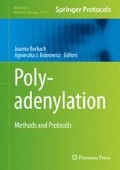Abstract
This chapter presents a method called PolyA-iEP that has been developed for the prediction of polyadenylation sites. More precisely, PolyA-iEP is a method that recognizes mRNA 3′ends which contain polyadenylation sites. It is a modular system which consists of two main components. The first exploits the advantages of emerging patterns and the second is a distance-based scoring method. The outputs of the two components are finally combined by a classifier. The final results reach very high scores of sensitivity and specificity.
Access this chapter
Tax calculation will be finalised at checkout
Purchases are for personal use only
References
Tzanis G, Kavakiotis I, Vlahavas I (2011) PolyA-iEP: a data mining method for the effective prediction of polyadenylation sites. Expert Syst Appl 38:12398–12408
Tzanis G, Kavakiotis I, Vlahavas I (2008) Polyadenylation site prediction using interesting emerging patterns. In: Proceedings of the 8th IEEE international conference on bioinformatics and bioengineering, IEEE, Athens, Greece, 2008
Agrawal R, Imielinski T, Swami A (1993) Mining association rules between sets of items in large databases. In: Proceedings of the ACM SIGMOD conference on management of data, 1993, Washington, DC, pp 207–216
Dong G, Li J (1999) Efficient mining of emerging patterns: discovering trends and differences. In: Proceedings of ACM-SIGKDD’99, 1999, San Diego, CA, pp. 43–52
Fan H (2004) Efficient mining of interesting emerging patterns and their effective use in classification. Ph.D. thesis, University of Melbourne, Australia
Han J, Pei J, Yin Y (2000) Mining frequent patterns without candidate generation. In: Proceedings of the 2000 ACM SIGMOD international conference on management of data, 2000, Dallas, TX, pp 1–12
Hall M, Frank E, Holmes G et al (2009) The weka data mining software: an update. SIGKDD Explor 11(1):10–18
Author information
Authors and Affiliations
Editor information
Editors and Affiliations
Rights and permissions
Copyright information
© 2014 Springer Science+Business Media New York
About this protocol
Cite this protocol
Kavakiotis, I., Tzanis, G., Vlahavas, I. (2014). Polyadenylation Site Prediction Using PolyA-iEP Method. In: Rorbach, J., Bobrowicz, A. (eds) Polyadenylation. Methods in Molecular Biology, vol 1125. Humana Press, Totowa, NJ. https://doi.org/10.1007/978-1-62703-971-0_11
Download citation
DOI: https://doi.org/10.1007/978-1-62703-971-0_11
Published:
Publisher Name: Humana Press, Totowa, NJ
Print ISBN: 978-1-62703-970-3
Online ISBN: 978-1-62703-971-0
eBook Packages: Springer Protocols

